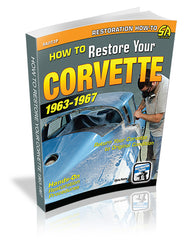How to Restore Your Corvette 1963-1967: Getting Started
by Chris Petris
Your plan should begin with considering what skills, tools, and equipment you have available. You need to decide if you will buy or rent equipment, or send the work out. Do you have a paint and body shop that you feel comfortable with? Will you be doing your own bodywork and paint?
THIS TECH TIP IS FROM THE FULL BOOK: HOW TO RESTORE YOUR CORVETTE: 1963-1967
For a comprehensive guide on this entire subject you can visit this link: LEARN MORE ABOUT THIS BOOK HERE
SHARE THIS ARTICLE: Please feel free to share this article on Facebook, in forums, or with any clubs you participate in. You can copy and paste this link to share: https://www.cartechbooks.com/blogs/techtips/restore-corvette-getting-started
Types of Restoration
You also need to determine whether you will do a body-on or body-off restoration. If you are on a tight budget, you should consider doing a body-on restoration. Although you may have the skills to do a body-off restoration, you need to consider this cost before taking the plunge. Body-off restorations are at a higher level altogether and usually leave no area untouched. When finished, the entire project is brought back to like-new condition.
The problem with doing a body-on restoration is that a very important part is left out of the project: properly inspecting the top of the chassis frame rails and the birdcage C-channels; to clean and preserve the frame and C-channels, you must remove the body.
Savvy potential buyers can spot a body-on restoration, and the value can be diminished. Many vehicles are body-on restored to save money and labor, which I can appreciate. The task does not seem nearly as daunting as a body-off project. Choosing a body-off option and taking the entire Midyear down to the last nut and bolt can sound so good. Be prepared, though, as there is no turning back once you start a body-off restoration. The reward will be great, however, when the final phases are completed and you can show off all your hard work.
This is a great example of why most Midyear restorations usually end up as body-off projects. The deteriorated rubber of body-mount cushions is commonplace after 20 years. At 50 years steel crumbles and the cushions in general are junk. These unsightly cushions will be seen by anyone who peers under your finished project. Chances are the cushions will require replacement, and it’s a lot of work to replace them with the body on; bite the bullet and lift the body if at all possible.
Also, the 1964 to 1967 Corvettes have body-to-frame cushions made of rubber with steel sleeves. This makes a strong case for lifting the body to replace the deteriorated rubber cushions. Rubber dries out and deteriorates over time, no matter how well it is treated. As the rubber cushions age, they lose their shape and become compressed. Steel sleeves that back up the rubber cushions corrode and further deform the rubber, causing the body to sag in places. Body cushions can be replaced without removing the body, although the labor is considerable, requiring some body lifting for cushion access.
Another consideration is that your Midyear Corvette project may be clean enough to do a body-on restoration if it has been restored in the recent past. A thorough inspection of the frame and body underside determines if this is feasible. Decent body mounts with minimal to no corrosion should allow you to perform a body-on restoration (and avoid a body-off restoration). Remember that down the road, a potential buyer will easily spot deteriorated body cushions. This could negatively affect the resale value, considering the labor cost to replace the cushions.
Once the project is at your work place, a proper plan provides goals and milestones to keep things going smoothly. While you are putting the plan together, you should order a GM factory service manual and assembly manual. Have a dedicated clipboard with legal pad handy to write notes as you scrutinize the project requirements. At the end of the week, it is a good idea to transcribe your lists to a computer document. Be sure to back up photos, parts lists, and labor operations on a DVD for your records.
Before any parts are removed, take photos of each assembly at multiple angles. No matter how good your recall is you’ll need a refresher when it comes time to put it all back together. Also photograph the work as you progress through each phase of disassembly, for future reference.
Remember to take photos of all the casting and date codes. This can save plenty of effort down the road for many purposes. Photos are good insurance verification and if you decide to sell you can show them to potential buyers. Keeping records of any new-old-stock (NOS) or original pieces installed can also add value.
One absolutely essential piece of advice: Do not discard any part until you are finished with the project. Even then, carefully consider whether or not is is worth saving.
THIS TECH TIP IS FROM THE FULL BOOK: HOW TO RESTORE YOUR CORVETTE: 1963-1967
For a comprehensive guide on this entire subject you can visit this link: LEARN MORE ABOUT THIS BOOK HERE
SHARE THIS ARTICLE: Please feel free to share this article on Facebook, in forums, or with any clubs you participate in. You can copy and paste this link to share: https://www.cartechbooks.com/blogs/techtips/restore-corvette-getting-started



